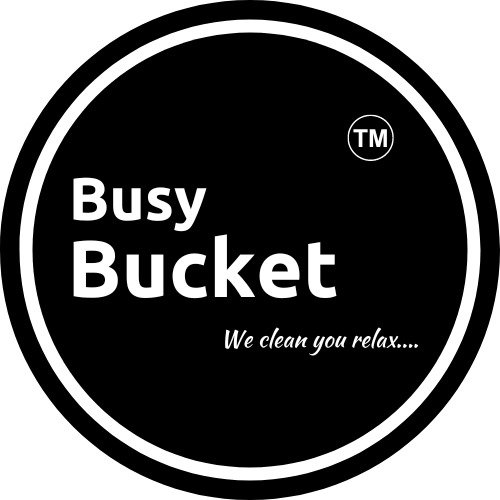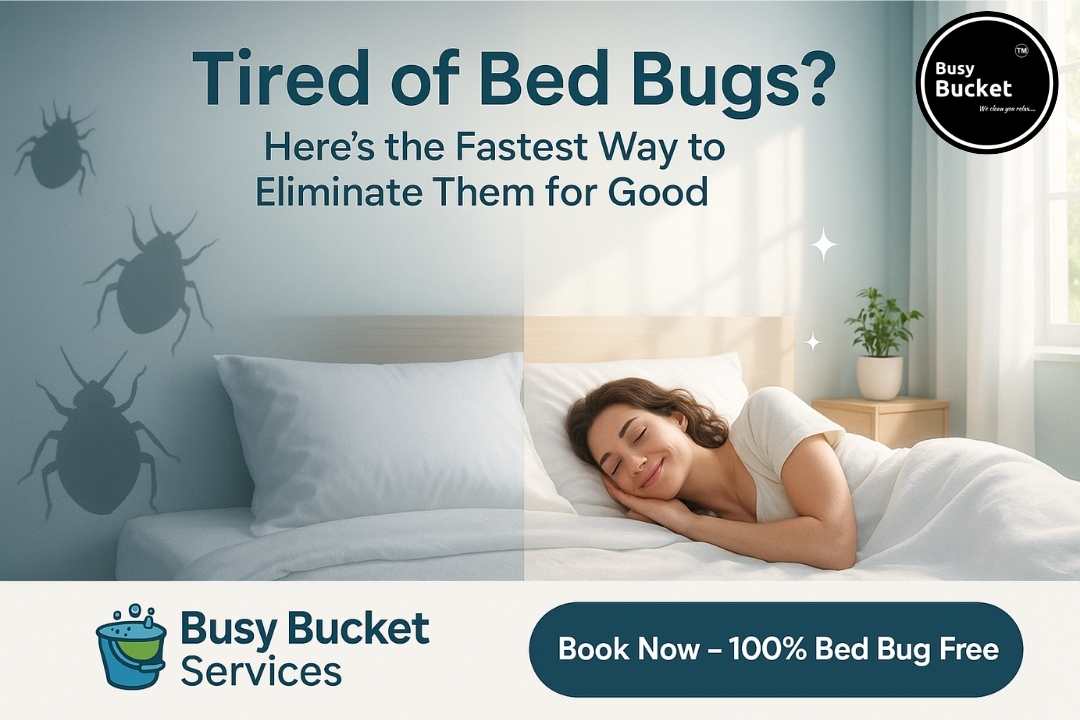Best Way to Get Rid of Bed Bugs
Rather than depending on short-term sprays, try these proven methods designed for complete elimination. Below is the best way to get rid of bed bugs effectively:
- Heat Treatment: Wash clothes, bedding, and linens in hot water and dry them at high heat.
- Vacuuming: Clean mattresses, bed frames, sofas, and surrounding cracks regularly to remove hidden bed bugs and their eggs.
- Steam Cleaning: Use steam on furniture seams and tight gaps where bed bugs hide.
- Encasements: Cover mattresses and box springs with bed-bug-proof covers.
- Professional Support: Hire experts for heat or chemical treatment if the infestation is severe.
Consistency is the key to success. Don’t let bed bugs disturb your sleep. Take action today and let Busy Bucket help you achieve a safe, clean, and pest-free home.
Step-by-Step Action Plan to Get rid of Bed Bugs:
Follow these proven steps for safe and effective results to remove bed bugs A clear plan can stop them fast:
Step 1: Confirm the Problem
- Check for live bugs (about the size of an apple seed), tiny white eggs, shed skins, or small blood stains on sheets.
- Check: mattress seams, bed frame joints, headboard, baseboards, sofa seams, and luggage.
- Use a flashlight and a credit card edge to inspect tight gaps.
Step 2: Isolate Your Sleeping Area
- Pull the bed 6–8 inches away from the wall.
- Remove bed skirts and anything touching the floor.
- Place interceptor cups under each bed leg to trap bugs moving to and from the bed.
Step 3: Heat-Treat What You Can
- Wash all bedding, pillow covers, blankets, and clothes on hot (60°C if fabric allows), then dry on high for at least 30 minutes.
- Seal cleaned items in fresh bags to prevent re-infestation.
- For items you can’t wash, dry on high heat if safe for the fabric, or place under direct sun in sealed black bags for several hours (heat helps).
Step 4: Deep Vacuuming (Daily for 1–2 Weeks)
- Vacuum along mattress seams, tufts, bed frame joints, headboard edges, baseboards, and any cracks in nearby furniture.
- Immediately seal and discard the vacuum bag (or empty a canister into a sealed bag) outside your home.
Step 5: Steam for Hidden Spots
- Use a garment or bed bug–rated steamer to reach seams and cracks (slow passes, 1-inch/second).
- Focus on mattress edges, bed frame joints, sofa seams, and baseboards.
- Let surfaces dry before making the bed.
Step 6: Targeted, Approved Products (Use Carefully)
- Prefer bed bugs–specific sprays or powders labeled for indoor use.
- Silica/diatomaceous earth (food-grade) can be dusted lightly into cracks and crevices. Avoid overuse; keep away from kids/pets and do not inhale.
- Avoid DIY “hacks” with kerosene, petrol, or outdoor pesticides unsafe and ineffective indoors.
Step 7: Seal and Encase
- Install bed-bug–proof encasements on the mattress and box spring. These trap any survivors and prevent new bugs from hiding inside.
- Seal wall cracks, lift outlet covers (power off first) only if you’re confident, or leave complex sealing to professionals.
Step 8: Declutter Without Spreading
- Reduce hiding spots.
- Bag items before moving them; label “treated” or “untreated.”
- Do not donate or toss untreated infested items; treat first.
Step 9: Inspect, Monitor & Repeat
- Recheck every 7–10 days: mattress seams, interceptors, baseboards, and furniture.
- Re-steam and re-vacuum hotspots.
- Continue until no signs appear for 30 days.
Consistency is key. Repeat these steps until no signs remain. Stay alert, and you’ll enjoy a complete bed bug–free home. If the situation is out of control. You can ask for Professional Pest Control services to get it off in one-go.
What Works Fast and What Doesn’t to get Rid of Bed Bugs:
Knowing what works and what doesn’t saves time and effort. Some methods give quick results, while others only waste energy. Here’s what you need to know:
Works Fast:
- Heat treatment (washing, drying, steaming)
- Mattress encasements and interceptors
- Regular vacuuming and inspections
Doesn’t Work Well:
- DIY foggers or bug bombs
- Strong-smelling home sprays like kerosene or alcohol
- Ignoring the problem and hoping it disappears
The best way to get rid of bed bugs is a combined strategy with consistency and professional support. Don’t struggle alone. Contact Busy Bucket today for expert solutions and long-lasting relief from bed bugs.
When to Call Professionals to get rid of Bed Bugs:
While home remedies and DIY methods can help in the early stages, sometimes bed bugs are too stubborn to handle alone. If you notice bites continuing after weeks of effort, bugs spreading to other rooms, or eggs and nymphs reappearing, it’s time to call experts. Professional treatment is the best way to get rid of bed bugs because it targets every stage of their life cycle, from eggs to adults. Our trained team at Busy Bucket uses safe and effective methods like heat treatment, deep cleaning, and follow-up inspections to ensure complete elimination. Don’t let bed bugs disrupt your sleep any longer. Contact Busy Bucket today and enjoy a cleaner, safer, and pest-free home.
Frequently Asked Questions
What’s the absolute best way to get rid of bed bugs fast?
A combined plan: heat (laundry/steam), deep vacuuming, encasements, interceptors, and repeat inspections or professional heat treatment.
How long until they’re gone?
Light cases: 2–3 weeks with consistent effort. Heavy cases: usually faster with professional treatment.
Can I sleep in the bed during treatment?
Yes, after encasing and isolating the bed. Your presence helps lure bugs into interceptors.
Are DIY sprays safe?
Only use indoor bed bugs–labeled products as directed. Avoid flammable or outdoor chemicals indoors.
Will they come back?
They can especially after traveling. Keep interceptors, encasements, and regular checks for early detection.


